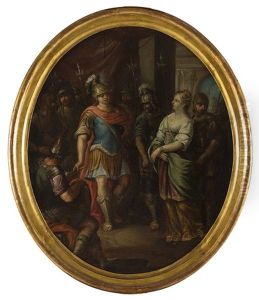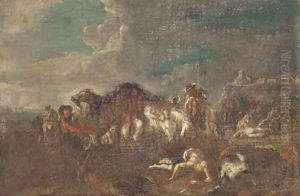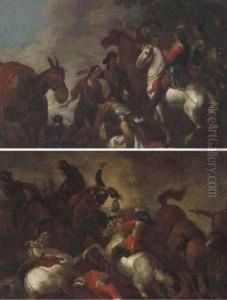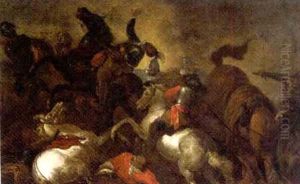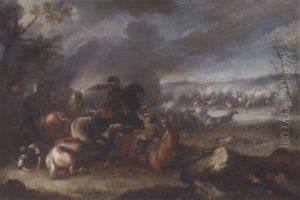Giovanni Tuccari Paintings
Giovanni Tuccari, born in 1667 in Messina, Italy, was an Italian Baroque painter who is recognized for his distinctive style that contributed to the late Baroque period. He is particularly noted for his vibrant battle scenes and intricate historical depictions, which showcased not only his technical skill but also his ability to capture the dynamism and drama of his subjects. Tuccari's work represents a significant part of the Italian Baroque movement, reflecting the era's artistic tendencies towards emotional expressiveness, bold use of color, and dramatic contrasts of light and shadow.
Tuccari's artistic journey began in his hometown of Messina, but his talent soon necessitated his move to Rome, where he could immerse himself in the burgeoning Baroque art scene. In Rome, he encountered the works of masters like Caravaggio and Pietro da Cortona, which greatly influenced his artistic development. His ability to synthesize these influences into a unique style helped him gain recognition amongst his peers and patrons. Tuccari's paintings often depicted historical and mythological themes, characterized by dynamic compositions and a rich palette.
Despite the challenges faced by many artists of his time, including competition and the devastating effects of natural disasters on his hometown, Tuccari's career flourished. He became a sought-after painter for both religious and secular commissions. His works were not only popular in Italy but also gained attention abroad. Throughout his career, Tuccari remained committed to exploring the possibilities of Baroque art, contributing significantly to its evolution.
Giovanni Tuccari's legacy is preserved in the collections of several Italian museums and churches, where his paintings continue to be admired for their vibrancy and emotional depth. He passed away in 1743, leaving behind a body of work that continues to be studied and appreciated by art historians and enthusiasts alike. Tuccari's contribution to the Baroque movement underscores the diversity and richness of Italian art during a period of intense creativity and innovation.
